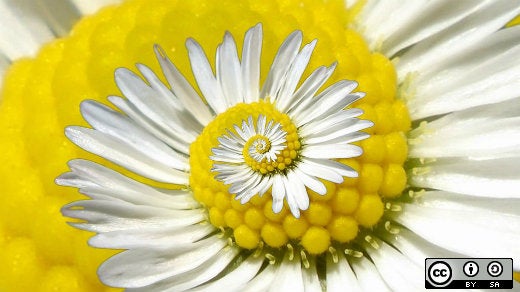Before I begin this test of Linux graphic design tools, I should admit two things up front. First, I am a designer, not a software developer. Second, although I try to incorporate open source methodologies and principles wherever I can, my field pretty much demands that I use Adobe software on a sticker-emblazoned MacBook Pro. (I know, hate me if you must.) For the purposes of this research project, however, I am running Fedora 29 on a repurposed Mac Mini.
The question I want to answer with this investigation isn't just how good is open source design software, but also could I use it to do my job every day?
What I expect from professional-grade design software
Design is more craft than art. Like a craftsperson, designers have to be flexible enough to accomplish a wide range of tasks, knowledgeable enough to know which tool is appropriate for which task, and thoughtful enough to leave space and breadcrumbs for the next worker down the line to make changes and perform maintenance without too much headache. Therefore, rather than ordering this list by title, let's segment the applications by task and see what open source design software works and what doesn't.
Assignment 1: Design a logo
A good logo typically has three features: It's clean and not too visually complex, color variation is kept to a minimum so we're not mortgaging the company to print stickers later, and it's scalable enough to work just as well on a 16px favicon as it does on a 10-foot hanging banner.
Logos are almost always drawn as vectors. The clean lines and scalability of vector graphics lend themselves to the needs of logo designers so perfectly that on the few occasions where someone isn't using a vector-based application, they really should be. Thankfully, vector graphics are also very forgiving for new and non-designers. If a line doesn't quite look right, it doesn't have to be redrawn, it can simply be changed.
Inkscape
Grade: A- (92/100)
License: GPLv2
Inkscape holds a place of honor in my memory for being the very first vector software I ever used. Being able to access it for free and run it on any operating system gave me the opportunity to use it in my early days. I must say that Inkscape has matured extremely well in the past few years. It has a fairly intuitive interface and simple controls. I would like to see some improvements in the color palette system, but overall there is very little you could accomplish in proprietary software that can't be matched in Inkscape with a little bit of persistence and finesse.
LibreOffice Draw
Grade: C- (71/100)
LIcense: Mozilla Public License 2.0
I went into this assignment hopeful for a better result; maybe I didn't study enough? Maybe I skipped too many lectures? But when I sat down for the lab, I really felt a little lost. LibreOffice Draw seems to me like a clone of the LibreOffice Impress slideshow app with a few words changed here and there (the tool-tip for new layers even calls them "slides") and the toolbar relocated from the top of the frame to the left. This is not to say it is necessarily a bad approach for a "does-what-you-need" diagram-drawing application, which is precisely how I imagine most people would use it.
If your goal is to generate some easy-to-read, end-user-editable assets that you can copy and paste into other LibreOffice applications, Draw might be perfect for you. However, like most designers, I'm particular about the finer points of visual design, therefore I prefer to do all of my work in my daily-use design tools and export higher-quality products for consumption by colleagues and stakeholders.
Assignment 2: Design an ad
If logos are a designer's bread and butter, then web ads are our toast and jam. Web ads can be done in vector-based software, but more often than not, they incorporate some photographic elements that are better handled by raster graphics applications. The ability to non-destructively manipulate imagery through layered editing and use fine type controls are paramount for this kind of task.
GIMP
Grade: A (96/100)
License: GPLv2
Much like Inkscape, GIMP was a foundational part of my exploration into digital visual arts. Up until my first experience with GIMP—on Mandrake Linux in the late '90s—my only experience with raster graphics had been with Microsoft Paint. Even then, GIMP was a more powerful tool then I fully understood, and although I still am not entirely clear on what exactly Wilber is, the software has definitely kept pace with other market-leading applications. GIMP is lacking some bleeding-edge features you'd find in other raster applications (like 3D modeling), but I'm not sure how many people use or need those things on a daily basis. If 3D modeling is necessary for a web ad, it's probably over-designed.
GIMP's interface is so thoughtfully laid out that moving from other applications shouldn't present too steep a learning curve. Good color tools, tight typography controls, and a comprehensive toolbar mean that GIMP is all aces in my book.
Assignment 3: Lay out a print publication
As time marches on, print design becomes more and more of a specialization for designers that requires its own set of tools. Desktop publishing is an understatement for everything involved with print design. Sure, we can throw down some paragraphs in 12pt Times New Roman and wrap them around some square images—and for the vast majority of people that is more than adequate. Print design is about unrelenting fastidiousness across a broad range of disciplines. A successful print designer understands typography (two full semesters of my college career alone), color theory, photography, illustration, human interaction (including reading and learning disabilities), and all the technologies and methodologies used by printers to bring their designs to life.
Dear reader, do you know that coder in your company who is kinda scary smart? The one who still remembers COBOL for some unknown reason and can spot your missing semicolon at a glance? You know the one who wrote a script to tell the coffee pot, which you didn't even know had a CPU let alone a network interface, to brew a fresh cup of coffee in the amount of time it takes to walk to the breakroom? If that person had gone to art school instead of Stanford, they would be the print designer.
Scribus
Grade: A+ (98/100)
License: GPLv2 or later
This was my first experience with Scribus, so I wasn't sure what to expect, but I found myself pleasantly surprised. The self-described "open source desktop publishing" tool is deceptively complex and powerful. Full-featured typography controls including overflowing textboxes and image-sensitive wrapping allow for beautiful and unique type treatments. Native image cropping and shape tools make it possible to visually enhance your copy with an editorial narrative. Support for traditional CMYK profiles and spot colors gives designers total control over the outcome of the final product. The contributors to Scribus were even thoughtful enough to include tools for color-blindness testing to make sure every design can be as inclusive as possible.
I have to admit, I am seriously impressed with Scribus.
Assignment 4: Wireframe a prototype
Oof. This one really fell short for me. The world is digital now. Interactive web apps, websites, and mobile applications are such a massive part of our lives that I purchased in a PopSocket literally just so that I might stop dropping my phone on my face at night. My dentist approves, but my wife misses the comedy.
Before the introduction of wireframe and prototyping tools, mockups were usually designed in raster graphics tools like GIMP or Photoshop. And while I could probably go back to doing some of my job this way, I would quickly become less popular among my stakeholders and engineering colleagues.
I'm sure there are plenty of perfectly good games, apps, and websites that have been developed without wireframes, but today, doing something right requires careful, in-depth planning. That means UX design, UI design, and a big ol' pile of interconnected wireframes.
Wireframing and prototyping tools are necessary to create virtually kickable prototypes that are visually developed enough to not frighten project managers and interactive enough to collaborate with engineers without wasting too much of their very expensive time. In the proprietary world, this means tools like SketchApp, InVision Studio, and Adobe XD. I couldn't locate an open source application that fit this need.
The final grade: B+
The lack of available wireframing and prototyping applications really brought down the average, but I'd still call it a successful exercise. As I mentioned at the beginning, design is a craft and it relies on collaboration. All of the tools I looked at—Inkscape, LibreDraw, GIMP, and Scribus—can run just as well on Windows or MacOS as they do on any Linux distribution. The ability to create robust artwork and share editable files with stakeholders and colleagues on the platform of their choice means that a serious argument could be made that these tools are even more versatile than their proprietary counterparts.
On a personal note, not only are GIMP and Inkscape the first real design tools I got to play with unsupervised, they opened up my mind to the possibility that design was a real job I could do someday. Without these open source software applications and the community contributors behind them, I wouldn't have this job as a UX designer for Red Hat today and I never would have left Ohio. So, I offer heartfelt gratitude to all of them. Even if all of these applications aren't perfect all the time, they're enough to inspire people to make cool new things, and if you ask this designer, making cool things is what being human is all about.
Extra credit
But what about (cough) running Adobe on Wine? (cough)
Yeah, I'm sure you can do it. But this isn't about breaking end user license agreements. I'm not about that life. This is about the efficacy of real, open source, design software running available on open source platforms, right now.
Does ChromeOS Count?
No. No, it does not.







25 Comments